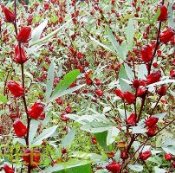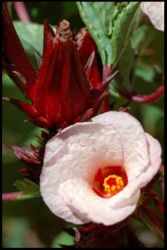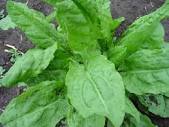Aubergine
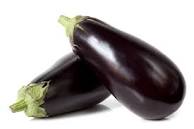 Aubergine or eggplant comes in all shapes and colours and is a member of the nightshade family, as are bell peppers, tomatoes and potatoes. Aubergine is full of vitamins B1 and B6 and high in potassium, manganese, copper and magnesium. It is also an excellent source of dietary fibre, which helps lower cholesterol, keeps the digestive tract healthy and assists with weight management. Aubergine is rich in antioxidants, especially nasunin which is found in the skin and which gives the aubergine its purple colour, this particular colour being more popular than the others. Nasunin protects the fatty acids in the brain thus helping with its proper functioning and also removes excess iron from the body. Aubergine is low in fat and is therefore very good for those with type 2 diabetes or weight issues and may help reduce high blood pressure.
Aubergine or eggplant comes in all shapes and colours and is a member of the nightshade family, as are bell peppers, tomatoes and potatoes. Aubergine is full of vitamins B1 and B6 and high in potassium, manganese, copper and magnesium. It is also an excellent source of dietary fibre, which helps lower cholesterol, keeps the digestive tract healthy and assists with weight management. Aubergine is rich in antioxidants, especially nasunin which is found in the skin and which gives the aubergine its purple colour, this particular colour being more popular than the others. Nasunin protects the fatty acids in the brain thus helping with its proper functioning and also removes excess iron from the body. Aubergine is low in fat and is therefore very good for those with type 2 diabetes or weight issues and may help reduce high blood pressure.
From a culinary perspective, aubergine has a slightly bitter taste which can be neutralized by steeping it in salt for about half an hour. Aubergine is quite perishable and is sensitive to both heat and cold. You can store them whole in a plastic bag in the ‘fridge for about five days. Visit our recipe section for ideas on cooking aubergines.
Breadfruit
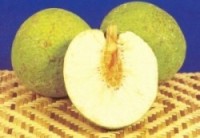 Breadfruit has been a very important crop in the Pacific region for over 3000 years and is also connected with Captain Blight and the Bounty. Apparently the ship was on its way to the Caribbean with a cargo of young breadfruit trees when the crew mutinied. The story says that the sailors were thirsty but the captain decided that the water was to be given to the young plants instead and it was this that started the mutiny. Breadfruit is not like any other fruit as it does not have the look, or consistency of a typical fruit. It looks more like bread and slices like bread.
Breadfruit has been a very important crop in the Pacific region for over 3000 years and is also connected with Captain Blight and the Bounty. Apparently the ship was on its way to the Caribbean with a cargo of young breadfruit trees when the crew mutinied. The story says that the sailors were thirsty but the captain decided that the water was to be given to the young plants instead and it was this that started the mutiny. Breadfruit is not like any other fruit as it does not have the look, or consistency of a typical fruit. It looks more like bread and slices like bread.
There are in fact two types of breadfruit, one, without seeds and a less popular variety, with seeds. As the name implies breadfruit is very much like bread in texture and can be used as a substitute. It can be cooked in many different ways. It can be boiled, roasted, baked and fried. Breadfruit is one of nature’s complex carbohydrates and provides warmth and energy. It is high in fibre and can be made into flour which is richer than wheat flour and contains more amino acids. It lowers LDL “bad” cholesterol, raises the good HDL cholesterol, helps with diabetes, because it is a complex carbohydrate and is low on the glycemic index. It also reduces the risk of colon cancer because of its fibre. The leaf of the breadfruit tree is said to reduce blood pressure and assist with asthma.
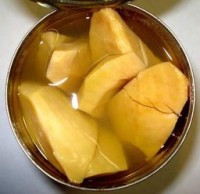 Breadfruits for immediate use should be slightly soft. They do not refrigerate well but can be cooked first and then frozen for future use. It is low in saturated fat, cholesterol and sodium and high in vitamin C, potassium, dietary fibre and omega 3 and 6. It is excellent if you are on a low fat diet and helps with liver and kidney problems. Breadfruit is high in fibre which reduces the absorption of glucose from the food we eat, helps regulate our bowel movements and clears out the built up junk from our intestines, reducing the risk of developing cancer of the colon..
Breadfruits for immediate use should be slightly soft. They do not refrigerate well but can be cooked first and then frozen for future use. It is low in saturated fat, cholesterol and sodium and high in vitamin C, potassium, dietary fibre and omega 3 and 6. It is excellent if you are on a low fat diet and helps with liver and kidney problems. Breadfruit is high in fibre which reduces the absorption of glucose from the food we eat, helps regulate our bowel movements and clears out the built up junk from our intestines, reducing the risk of developing cancer of the colon..
One of my favourite ways to eat breadfruit, is to get one that is very ripe, peel, slice and boil it, then eat it mashed with bits of salt beef about twice the size of a thumbnail in it. You need lashings of gravy with it though.
Cassava
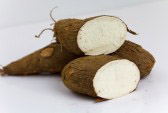 Also known as manioc, tapioca and yuca depending on which part of the world you are located. Cassava has twice as much fibre as potatoes and more potassium than bananas. It is yet another of nature’s complex carbohydrates and has been used to treat rheumatoid arthritis, diabetes, colon cancer, stress and irritable bowel syndrome, due to its high fibre content.
Also known as manioc, tapioca and yuca depending on which part of the world you are located. Cassava has twice as much fibre as potatoes and more potassium than bananas. It is yet another of nature’s complex carbohydrates and has been used to treat rheumatoid arthritis, diabetes, colon cancer, stress and irritable bowel syndrome, due to its high fibre content.
There are two types of cassava known as “sweet” and “poisonous.” The former is edible immediately it is harvested but the latter has to go through a process whereby the juice is squeezed from the root and turned into starch. The left over pulp is then used to make cassava flour. On the South American continent this forms the basis of a popular dish known as “pepper pot”.
Dasheen/Taro
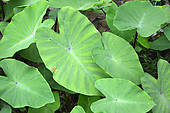 Taro is the common name for the tubers or corms of several plants. Of these the dasheen is the most cultivated. Another variety is known as eddoes or in some English speaking West Indian islands “Tanya” or “Tanya eddoes”. Cocoyam is also another name for dasheen. Taro is a tropical plant which is grown mainly as a root vegetable, although the leaves are eaten in some cultures. In colder climates it is grown as an ornamental plant and often referred to as “elephant ears”.
Taro is the common name for the tubers or corms of several plants. Of these the dasheen is the most cultivated. Another variety is known as eddoes or in some English speaking West Indian islands “Tanya” or “Tanya eddoes”. Cocoyam is also another name for dasheen. Taro is a tropical plant which is grown mainly as a root vegetable, although the leaves are eaten in some cultures. In colder climates it is grown as an ornamental plant and often referred to as “elephant ears”.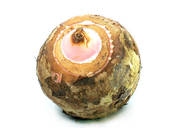
The tubers or corms can be roasted, baked or boiled and the natural sugars give this vegetable a sweet nutty flavour. It is often used as baby food as the starch is easy to digest. There are noticeable differences between the three. Dasheen, the largest, is mostly blue when it is cooked, tanya is white and very dry and eddoes, the smallest, are slimy. In some parts of the West Indies the leaves are often cooked and pureed into a thick liquid called callaloo which is somewhat similar to spinach and is usually served as a side dish. This is part of the national dish of Trinidad &Tobago.
In Ghana, which produces 1.5 metric tons a year, dasheen is used in the making of fufu when plantains are out of season. It is also cut into small pieces to make a soupy baby food known as “mpotompoto”. The leaves are a good source of vitamins A and C and contain more protein than the tubers. There are also useful amounts of potassium and zinc in the leaves and tubers. It is recommended that milk or some other calcium rich food (broccoli, coconut) be eaten with dasheen as it contains an insoluble compound known as calcium oxalate which contributes to kidney stones.
Okra
 Okras, also known as lady’s finger or gumbo are very low in calories with no cholesterol or saturated fats. They are also very high in dietary fibre, minerals and vitamins. Okras also contain vitamin A and flavonoid anti-oxidants such as beta-carotenes, xanthin and lutein. They are also rich in the B vitamins and vitamin K which is essential for blood clotting. Minerals such as iron, magnesium, calcium and manganese are also found in okras. If you are diabetic try putting a few okras in a bowl of warm water, leave it overnight and drink the water the following day. This has been recommended as a way to help reduce diabetes. Of course you then use the okras in your cooking. More often than not the okra vegetable itself is eaten but the leaves can also be cooked and eaten or even eaten raw as part of a salad.
Okras, also known as lady’s finger or gumbo are very low in calories with no cholesterol or saturated fats. They are also very high in dietary fibre, minerals and vitamins. Okras also contain vitamin A and flavonoid anti-oxidants such as beta-carotenes, xanthin and lutein. They are also rich in the B vitamins and vitamin K which is essential for blood clotting. Minerals such as iron, magnesium, calcium and manganese are also found in okras. If you are diabetic try putting a few okras in a bowl of warm water, leave it overnight and drink the water the following day. This has been recommended as a way to help reduce diabetes. Of course you then use the okras in your cooking. More often than not the okra vegetable itself is eaten but the leaves can also be cooked and eaten or even eaten raw as part of a salad.
Plantain
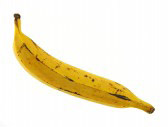 A member of the banana family, of which there are 250 varieties. Plantain is also known as the vegetable banana because it has to be cooked before being eaten. Plantain is starchy, low in sugar, saturated fats, cholesterol and sodium and is a good source of potassium, fibre, magnesium, folate and vitamins A, C and B6. Plantains contain more potassium than bananas.
A member of the banana family, of which there are 250 varieties. Plantain is also known as the vegetable banana because it has to be cooked before being eaten. Plantain is starchy, low in sugar, saturated fats, cholesterol and sodium and is a good source of potassium, fibre, magnesium, folate and vitamins A, C and B6. Plantains contain more potassium than bananas.
Yams are complex carbohydrates and are full of soluble fibre, which is beneficial to the digestive system. This makes them a useful addition to a diabetic control regime. Yams may help reduce LDL “bad” cholesterol and are a source of vitamin A, the B complex vitamins and the trace minerals iron and copper.
Pumpkin
Pumpkin is another complex carbohydrate from mother nature and like all other vegetables of this type is extremely beneficial to those who are diabetic or pre- diabetic. The flesh of this vegetable is high in carotenoids as evidenced by the orange colour and we know that carotenoids are very helpful in staving of free radicals thus preventing premature aging.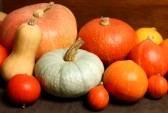
Pumpkins are also a natural diuretic and help to flush toxins from the body in addition to helping reduce the incidence of kidney stones. Pumpkins are full of vitamin A, C , magnesium, potassium and fibre and have anti-inflammatory properties. They are also powerful anti- oxidants. The seeds are especially useful for the health of the prostate gland due to their high content of zinc.
Red Kidney Beans
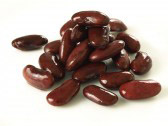 Now considered to be one of the top twenty health foods, red kidney beans are especially beneficial to the heart due to the fact that although they contain a large amount of protein, there is no cholesterol or saturated fat, unlike red meats. They are high in both soluble and insoluble fibre both of which are important for colonic health and proper elimination. Insoluble fibre is the woody part of food that passes undigested through the small intestines. Soluble fibre forms a gel when mixed with liquid and binds to cholesterol and other fats in the bowel and reduces their absorption. Because of this absorption of body liquids it is important to replace the lost fluids by drinking more. Beans and other pulses are said to be responsible for reductions in LDL “bad” cholesterol and increases in HDL “good” cholesterol Beans are also very effective in relieving constipation, diarrhoea and irritable bowel syndrome
Now considered to be one of the top twenty health foods, red kidney beans are especially beneficial to the heart due to the fact that although they contain a large amount of protein, there is no cholesterol or saturated fat, unlike red meats. They are high in both soluble and insoluble fibre both of which are important for colonic health and proper elimination. Insoluble fibre is the woody part of food that passes undigested through the small intestines. Soluble fibre forms a gel when mixed with liquid and binds to cholesterol and other fats in the bowel and reduces their absorption. Because of this absorption of body liquids it is important to replace the lost fluids by drinking more. Beans and other pulses are said to be responsible for reductions in LDL “bad” cholesterol and increases in HDL “good” cholesterol Beans are also very effective in relieving constipation, diarrhoea and irritable bowel syndrome
Beans come with a reputation as having an unpleasant side effect but this can be easily overcome by soaking the beans overnight, especially in hot water and then discarding that water before cooking the beans. Another reason for discarding the water is that these beans are mildly toxic and whatever toxicity there is leaches into the water. having discarded the water you then rinse them and away you go. Kidney beans absorb the flavour of seasonings and other foods with which they are cooked and are very low on the glycemic index, making them an ideal food for diabetics and pre-diabetics. High fibre diets are associated with low incidences of prostate and breast cancer. Kidney beans are best served with rice because they do not contain all nine amino acids and rice provides the complementary amino acids. Brown rice, which is not polished like white rice, is also beneficial as it still has some of the rice bran and fibre. Beans contain copper, phosphorous, zinc, magnesium , selenium, folate, thiamine, niacin, riboflavin and vitamins C, K, E and B6. All, vital for optimum health.
Black eye peas are also now considered to be one of the top twenty health foods and like kidney beans are high in soluble fibre, which helps your body get rid of excess cholesterol, they are low in calories and full of carbohydrates and protein.
Sorrel
Sorrel (hibiscus sabdariffa) is a plant which grows in tropical and sub-tropical regions. A drink made from the calyx is a powerful antioxidant with properties as potent as cranberry juice and pomegranates. It helps to lower LDL “bad” cholesterol, helps with detoxification, boosts the immune system, reduces triglycerides, used to prevent diabetes, hypertension heart disease and has also been promoted as an anti- cancer agent. It also contains vitamin C, calcium, niacin, riboflavin and flavonoids which give it its deep red colour.
The name sorrel derives from the French “surelle” which means sour as the drink is somewhat tart. The calyx is the red sepals that actually protect the flower buds. I make this point as some people think, quite erroneously, that sorrel drink is actually made from the flower. Because of its Latin name (hibiscus sabdariffa) it is also confused with the ornamental hibiscus to which it is related and whose flower is made into a tea. They are, however, different, in the same way that bell peppers, white potatoes and tomatoes all belong to the “nightshade” family but are different vegetables. In the Caribbean sorrel drink was a seasonal beverage consumed around Christmas time but its health benefits are making it a drink that is consumed throughout the year, but a word of warning for those who suffer from gout, kidney disease and arthritis, sorrel may worsen your condition.
In some cultures the sorrel plant is cultivated primarily for the fibre from its stem which can be used as a substitute for jute in the making of burlap bags (crocus bags). The green leaves are used as a spicy version of spinach, especially in Sri Lanka. They are also the main ingredient in in a Burmese curry known as “chin baung Kyan”
Hibiscus, of which they are several hundred species, is mainly grown for its very showy flowers or used as a landscape shrub to attract butterflies, bees and humming birds. It is a member of the mallow family and sometimes goes by the name “rose mallow” or by its more formal name “rosa sinensis”. The flowers come in many beautiful colours ranging from bright red to pink, purple, white, orange and yellow and have long stamens, which make for easy pollination.
Tea made from the flower has a tangy flavour and can be served hot or cold. It is very popular in some parts of the world and goes by many different names. In West Africa it is known as bissap, in Egypt as karkade’ , in Brazil as congura and in Mexico and Honduras as “agua de Jamaica” (Jamaican water). Some people also refer to hibiscus as “roselle” as this is a common name for the flower. The hibiscus tea is a natural diuretic and contains vitamin C and minerals and is said to lower blood pressure. Dried hibiscus petals are edible and are often used as a delicacy in Mexico. Nowadays, certain species are being used more widely as a natural source of food colouring. Hibiscus is the national flower of Haiti, South Korea and Malaysia and the red variety is the flower of the Hindu goddess Kali.
European sorrel (rumex acetosa) is a spinach like herb which is also used as a leaf vegetable and is grown mainly in temperate climates, such as Europe and should not be confused with the tropical/subtropical plant. Its Latin name “rumex” means “I suck” as Roman soldiers and field workers used to suck the leaves to relieve thirst. European sorrel also goes by many other names such as common sorrel, spinach dock, narrow leaf dock and garden sorrel. There are three varieties of this herb/vegetable but the “rumex acetosa” is the most common. The two others are “rumex scutatus” or French sorrel as it is very popular in France. In England it is called Buckler Leaf Sorrel and has smaller leaves and a milder flavour. The third variety is called “rumex acetosella” and goes by the name of sheep’s sorrel. This variety is not generally cultivated but grows wild. The leaves of the European sorrel can be pureed in soups and sauces or added to salads. They have a flavour similar to kiwi fruits or sour wild strawberries. This sharp taste is due to oxalic acid which is poisonous, so you should not eat large quantities of this leaf vegetable as that could be fatal.
Medicinally, European sorrel is added to soups to treat jaundice, itchy skin, fever, scurvy and ringworms but can also be used to treat kidney stones. As a diuretic it cleans the body’s systems and is said to have a positive effect on the prostate gland. A combination of leaves, seeds and roots is said to be very effective in treating hemerrhoids. It is the European sorrel that is a component of Essiac Tea (Ojibwa Tea of Life), which is used as an anti-cancer beverage.
Sweet Potato
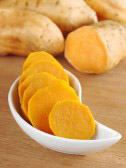 Sweet potato is one of nature’s best carbohydrates and now regarded by many as the top health food. Unlike the white potato (commonly referred to as Irish/English potato) the tropical/subtropical vegetable is very low on the glycemic index, meaning that it does not dramatically raise your blood sugar level when eaten and is therefore very good for those who suffer from diabetes. Simple carbohydrates, like some breads and cakes, cause a dramatic spike in blood sugar levels when eaten and can be dangerous for diabetics. Sweet potato is a complex carbohydrate which makes you feel full for a long period of time, releasing its sugars slowly, thus preventing a spike in blood sugar levels.
Sweet potato is one of nature’s best carbohydrates and now regarded by many as the top health food. Unlike the white potato (commonly referred to as Irish/English potato) the tropical/subtropical vegetable is very low on the glycemic index, meaning that it does not dramatically raise your blood sugar level when eaten and is therefore very good for those who suffer from diabetes. Simple carbohydrates, like some breads and cakes, cause a dramatic spike in blood sugar levels when eaten and can be dangerous for diabetics. Sweet potato is a complex carbohydrate which makes you feel full for a long period of time, releasing its sugars slowly, thus preventing a spike in blood sugar levels.
Sweet potato has many health benefits in addition to that mentioned above. The orange coloured variety gets its pigmentation from the beta carotene it contains. Beta carotene as you know converts into vitamin A when digested and this vitamin is especially good for your eyesight, especially night vision. In addition to this sweet potato is full of vitamin C, B6, potassium iron, fibre and manganese.
In 1992 the Centre for Science in the Public Interest compared the nutritional value of sweet potatoes to other vegetables. The sweet potato ranked highest in nutritional value considering fibre content, protein, complex carbohydrates, vitamin A and C, iron and calcium. Sweet potato earned 184 points and was 100 points ahead of irs nearest rival the common potato.
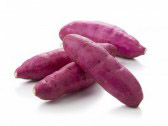 There are about 1000 varieties of sweet potato and they come in many colours ranging from orange, yellow, red brown, purple and beige and the flesh can also be quite colourful from white, beige, red, pink, violet, orange, yellow and purple. Potatoes with white or pale yellow flesh are usually as sweet and moist as those with red, pink or orange flesh. In certain parts of the world young leaves and shoots of sweet potato are sometimes eaten as greens.
There are about 1000 varieties of sweet potato and they come in many colours ranging from orange, yellow, red brown, purple and beige and the flesh can also be quite colourful from white, beige, red, pink, violet, orange, yellow and purple. Potatoes with white or pale yellow flesh are usually as sweet and moist as those with red, pink or orange flesh. In certain parts of the world young leaves and shoots of sweet potato are sometimes eaten as greens.
The sweet potato was domesticated about 5000 years ago in South America and remnants have been found dating back 8000 years. The sweet potato was also growing in Polynesia well before westerners arrived there and has been carbon dated to the Cook Islands to 1000 AD, suggesting that there was contact between South America and Polynesia at that time. Sweet potato is now cultivated throughout the tropics and rarely need pesticides.
Try some sweet potato and black eye pea soup to warm yourself. Add some cinnamon, cloves and black pepper.

